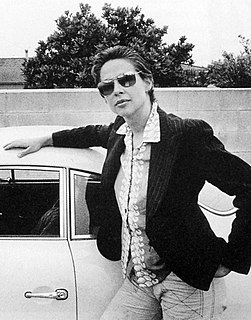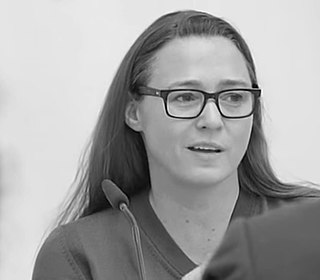Related Research Articles
Alice Könitz is an artist based in Los Angeles. Her sculptures, films, and collages use a formal language that is influenced by the contemporary built environment and early modernism. Könitz studied at the Kunstakademie in Duesseldorf and at Cal Arts.

Lynda Benglis is an American sculptor and visual artist known especially for her wax paintings and poured latex sculptures. She maintains residences in New York City, Santa Fe, New Mexico, Kastellorizo, Greece, and Ahmedabad, India.
K8 Hardy is an American artist and filmmaker. Hardy's work spans painting, sculpture, video, and photography and her work has been exhibited internationally at the Whitney Museum of American Art, Tate Modern, Tensta Konsthalle, Karma International, and the Dallas Contemporary. Hardy’s work is included in the permanent collections of the Whitney Museum of American Art, the Solomon R. Guggenheim Museum, and the Museum of Modern Art. She is a founding member of the queer feminist artist collective and journal LTTR. She lives and works in New York, New York.

Jessica Stockholder is a Canadian-American artist known for site-specific installation works and sculptures that are often described as "paintings in space." She came to prominence in the early 1990s with monumental works that challenged boundaries between artwork and display environment as well as between pictorial and physical experience. Her art often presents a "barrage" of bold colors, textures and everyday objects, incorporating floors, walls and ceilings and sometimes spilling out of exhibition sites. Critics suggest that her work is informed by diverse artistic traditions, including abstract expressionism, color field painting, minimalism and Pop art. Since her early career, they have noted in her work an openness to spontaneity, accident and marginality and a rejection of permanency, monetization and disciplinary conventions that Stephen Westfall characterized as an "almost shocking sense of freedom."
A K Dolven is a Norwegian artist. She works across painting, film, sound, sculpture and interventions in public space.

Charles Ross is an American contemporary artist known for work centered on natural light, time and planetary motion. His practice spans several art modalities and includes large-scale prism and solar spectrum installations, "solar burns" created by focusing sunlight through lenses, paintings made with dynamite and powdered pigment, and Star Axis, an earthwork built to observe the stars. Ross emerged in the mid-1960s at the advent of minimalism, and is considered a forerunner of "prism art"—a sub-tradition within that movement—as well as one of the major figures of land art. His work employs geometry, seriality, refined forms and surfaces, and scientific concepts in order to reveal optical, astronomical and perceptual phenomena. Artforum critic Dan Beachy-Quick wrote that "math as a manifestation of fundamental cosmic laws—elegance, order, beauty—is a principle undergirding Ross’s work … [he] becomes a maker-medium of a kind, constructing various methods for sun and star to create the art itself."

Maria Nordman is known for creating the contexts of FILM ROOMS starting in 1967: FILM ROOM EAT 1967-PRESENT and FILM ROOM EXHALE 1967- PRESENT. These two works are the fulcrum of other works that follow, of other works that follow, enabling new considerations of rooms as sculpture. Her works in film, still photography, and sculpture variously connect to writing, musical projects, architecture, public space, and performance.
Nancy Marmer is a writer, art critic and editor who lives in New York City.

Sharon Lockhart is an American artist whose work considers social subjects primarily through motion film and still photography, often engaging with communities to create work as part of long-term projects. She received her BFA from the San Francisco Art Institute in 1991 and her MFA from Art Center College of Design in 1993. She has been a Radcliffe fellow, a Guggenheim fellow, and a Rockefeller fellow. Her films and photographic work have been widely exhibited at international film festivals and in museums, cultural institutions, and galleries around the world. She was an associate professor at the University of Southern California's Roski School of Fine Arts, resigning from the school in August 2015 in response to the continued administrative turmoil at Roski to take a position at the California Institute for the Arts. Lockhart lives and works in Los Angeles, California.
Mary Corse is an American artist who lives and works in Topanga, California. Fascinated with perceptual phenomena and the idea that light itself can serve as both subject and material in art, Corse's practice can be seen as existing at an crossroads between American Abstract Expressionism and American Minimalism. She is often associated with the male-dominated Light and Space art movement of the 1960s, although her role has only been fully recognized in recent years. She is best known for her experimentation with radiant surfaces in minimalist painting, incorporating materials that reflect light such as glass microspheres. Corse initially attended University of California, Santa Barbara starting in 1963. She later moved on to study at Chouinard Art Institute, earning her B.F.A. in 1968.
Jennifer Bolande is an American artist whose work employs various media—primarily photography, sculpture, film and site-specific installations to explore the affinities between particular sets of objects and images and the mercurial meanings they manufacture.
Lisa Lapinski is an American visual artist who creates dense, formally complex sculptures which utilize both the language of traditional craft and advanced semiotics. Her uncanny objects interrogate the production of desire and the exchange of meaning in an image-based society. Discussing a group show in 2007, New York Times Art Writer Holland Cotter noted, "An installation by Lisa Lapinski carries a hefty theory- studies title: 'Christmas Tea-Meeting, Presented by Dialogue and Humanism, Formerly Dialectics and Humanism.' But the piece itself just looks breezily enigmatic." It is often remarked that viewers of Lapinski's sculptures are enticed into an elaborate set of ritualistic decodings. In a review of her work published in ArtForum, Michael Ned Holte noted, "At such moments, it becomes clear that Lapinski's entire systemic logic is less circular than accumulative: What at first seems hermetically sealed is often surprisingly generous upon sustained investigation." Lapinski's work has been exhibited widely in the US and Europe, and she was included in the 2006 Whitney Biennial.

Albert Robert Valentien (1862–1925) was an American painter, botanical artist, and ceramic artist. He is best known for his work as the chief ceramics decorator at Rookwood Pottery, and for his watercolor paintings of botanical subjects. In 1908, he accepted a commission from philanthropist Ellen Browning Scripps to illustrate the botanical diversity of California. Over the next ten years, he produced approximately 1200 watercolor "plant portraits" of native California wildflowers, grasses, ferns, and trees.
Erika Vogt is a sculptor, printmaker and video artist. She received her BFA from New York University and her MFA from California Institute of the Arts. She is represented at both Overduin & Co. in Los Angeles and Simone Subal Gallery in New York City.
Kaari Upson was an American artist. The bulk of Upson’s career was devoted to a single series titled The Larry Project – paintings, installations, performances, and films inspired by a collection of one man's personal items she found in 2003. The Larry Project was exhibited at the Hammer Museum in Los Angeles in 2008, as part of their program Hammer Projects. Her work resides in the public collections of the Whitney Museum of American Art, the Museum of Contemporary Art, Los Angeles, and the Institute of Contemporary Art, Boston and is known for exploring themes of psychoanalysis, obsession, memory, and the body. She had lived and worked in Los Angeles.
Danielle Dean is a British-American visual artist. She works in drawing, installation, performance and video. She has exhibited in London and in the United States; her work was included in an exhibition at the Hammer Museum focusing on new or under-recognized artists working in Los Angeles.
Won Ju Lim is a Korean American artist. She currently divides her time between Los Angeles, CA and Boston, MA.

Anna Sew Hoy is an American sculptor based in Los Angeles, California. She works primarily in clay, a medium she has been drawn to since high school. Sew Hoy’s works are abstract and blend found everyday items with uniquely crafted ceramic pieces to evoke a familiar yet uncanny response. Noting the performative aspect of working with clay, Sew Hoy has often engaged other artists to activate her sculptural installations through performance. Art critic Christopher Miles has called the artist’s work “utterly contemporary… in both its go-lightly cannibalism with regard to boomer-era agendas and preoccupations—from Funk art and folk craft to essentialist symbolism—and its openness to the cultural forms and detritus of its moment as legitimate grist for serious artmaking.”
Willa Nasatir is an American visual artist and photographer. In 2017, Nasatir presented a solo exhibition at the Whitney Museum organized by Jane Panetta.

Lynn Aldrich is an American sculptor whose diverse works draw on a wide range of high and low cultural influences and materials. Her work can range from what art writers describe as "slyly Minimalist meditations" on color, light and space to whimsical "Home Depot Pop" that reveals and critiques the excesses—visual, formal and material—of unbridled consumption. Critics Leah Ollman and Claudine Ise of the Los Angeles Times have described Aldrich's art, respectively, as a "consumerist spin on the assemblage tradition" and a "witty and inventive brand of kitchen-sink Conceptualism" LA Weekly critic Doug Harvey calls her "one of the most under-recognized sculptors in L.A.," whose hallmarks are the poetic transformation of found/appropriated materials, formal inventiveness and restless eclecticism. Aldrich has exhibited at the Museum of Contemporary Art, Los Angeles (MOCA), Los Angeles County Museum of Art (LACMA), Hammer Museum, Santa Monica Museum of Art, and venues throughout the United States and Europe. She has been recognized with a Guggenheim Fellowship (2014) and public art collection acquisitions by LACMA, MOCA Los Angeles and the Portland Art Museum, among others.
References
- ↑ "Margaret Honda: Artist Statement". California Community Foundation. Retrieved 11 January 2016.
- ↑ Barshee, Tenzing (9 April 2016). "Margaret Honda "Sculptures" and "Moucharabieh" at Triangle France, Marseilles". Mousse Magazine. Retrieved 11 January 2016.
- ↑ Pinkerton, Nick (7 January 2016). "First-Come, First-Served". Artforum. Retrieved 11 January 2016.
- ↑ Jori Finkel (June 19, 2016), ‘Made in L.A.,’ at the Hammer, Excavates Hollywood’s Past New York Times .